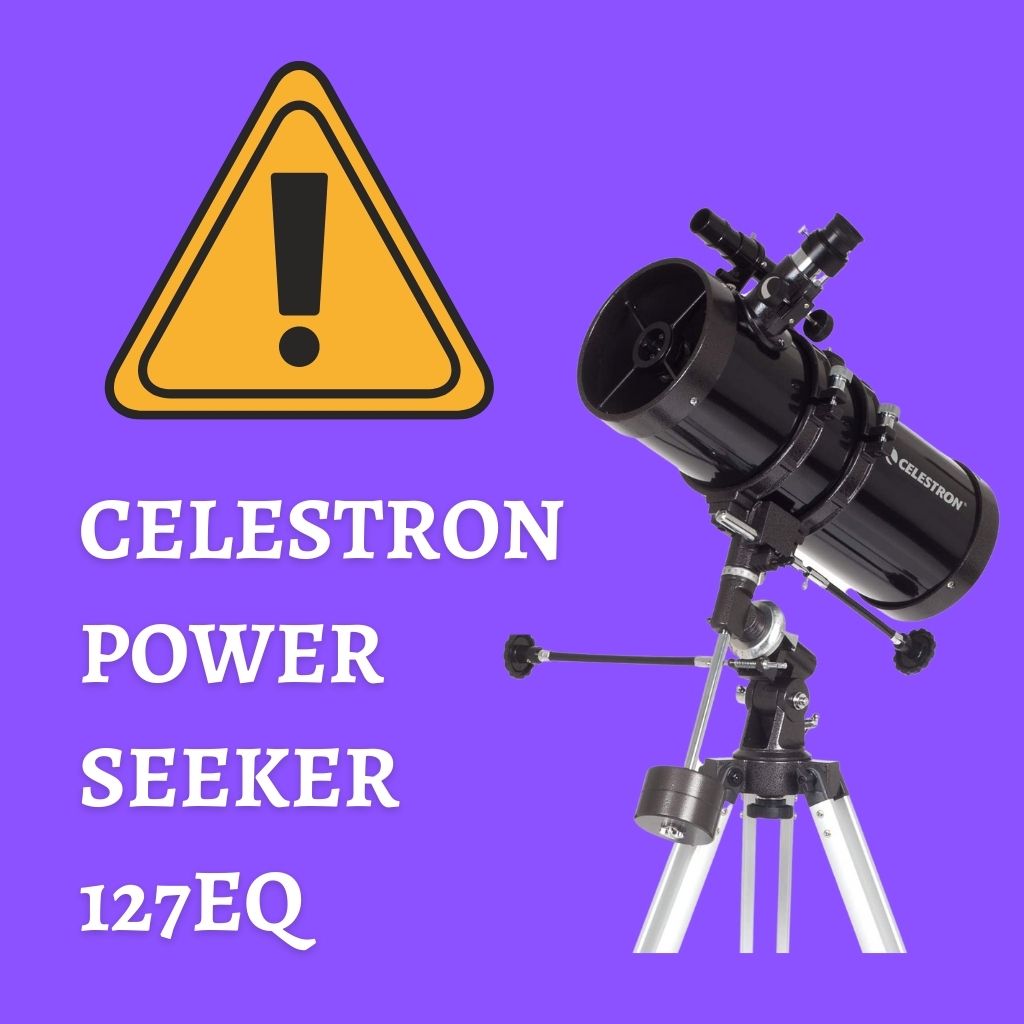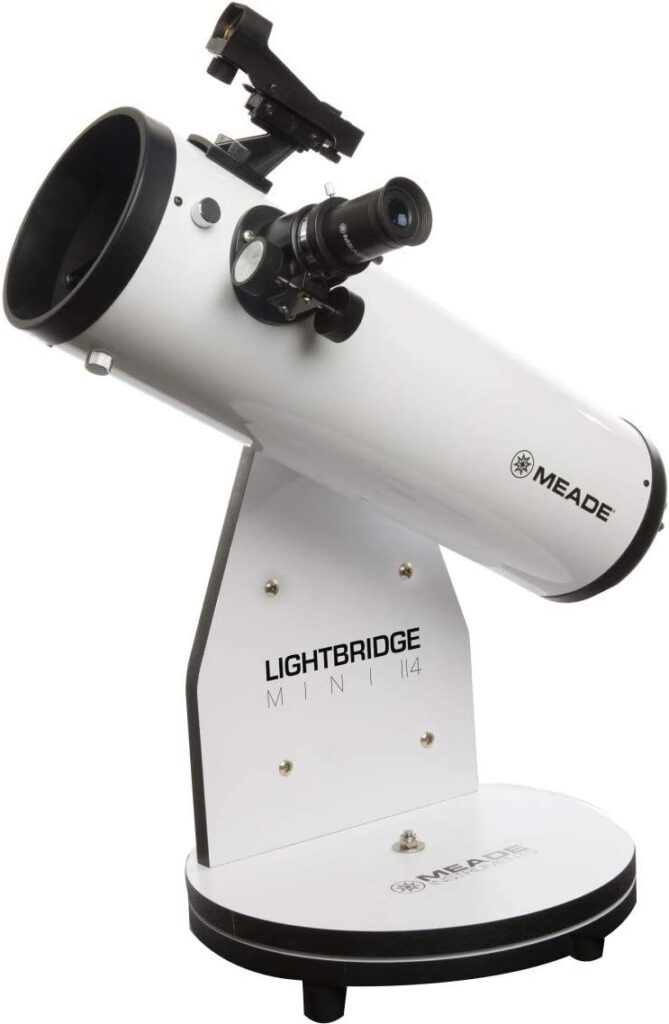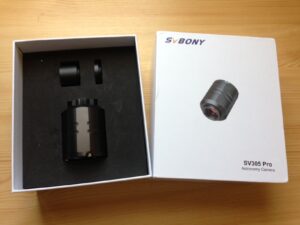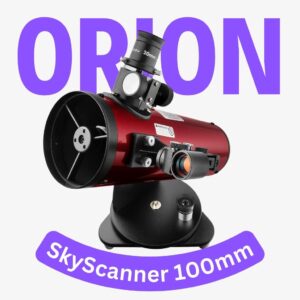This site contains affiliate links to products. I may receive a commission for purchases made through these links.
As an amateur astronomer, I’m always looking into new telescopes, just browsing and looking for my next upgrade, even if I’m not planning to upgrade soon.
While browsing Amazon, I discovered that the #1 Bestselling reflecting telescope is one of the worst telescopes I know. So I decided to write a full review to explain why it is so and why you should avoid buying this telescope.
The Celestron PowerSeeker 127EQ has a wide 5-inch aperture, a focal length of 1000mm, and a focal ratio of f/7.87. Despite its affordable price, the telescope is not ideal for beginners due to collimation challenges and the undersized mount. There are much better alternatives available at the same price range.
Keep reading for a detailed review of the PowerSeeker 127EQ including its specifications, optical performance, and pros and cons. You’ll also see four great alternatives to the Celestron PowerSeeker 127EQ.
Why is Celestron PowerSeeker 127EQ the best-selling reflecting telescope?
The main reason the Celestron PowerSeeker 127EQ is the best-selling reflecting telescope is that it is cheap. You can get it for around $130, which is tempting for beginners looking for their first telescope. The second reason is that it looks good – kind of professional for this price. And last, it’s bestselling because it has mostly good reviews.
However, these reviews are from people with very low expectations who probably have never seen the night sky through a decent telescope, and additionally, some reviews can be paid.
It is advertised as an entry-level telescope for beginners – small, portable, and with high magnification.
Although it is a small telescope, it has a long focal length which can provide advertised high magnification and portability, but this is because it has a Bird-Jones optical design that I will explain later.
The aperture of this telescope is 127mm or 5inch which is very good for this price, and a 5-inch telescope can show you many beautiful things, but it is killed with the Bird-Jones design it has.
My head spins when I see “astronomy” blogs recommending this telescope for beginners. If you check the astronomy forums, you will not find one good word about this telescope, so it makes no sense why it is the bestselling telescope on Amazon.
Let me explain why the Celestron PowerSeeker 127EQ is not the best beginner telescope you can buy.
From my experience, the price is the main factor when looking for the first telescope. Another thing is that there are so many options you can choose from that you need extensive research before buying anything, especially if you’ve never owned or used a telescope before and you don’t know what you are looking for.
So I will point out the main reasons you should avoid buying it, and you can apply it to any telescope you have on your radar.
If you are convinced and will not buy the Celestron PowerSeeker 127EQ, scroll down to the end of this article, where I give much better alternatives to the PowerSeeker 127EQ within the same price range.
Okay, so let’s take a closer look at the Celestron PowerSeeker 127EQ.
Specifications of the Celestron PowerSeeker 127EQ
First, it’s a Newtonian Reflector telescope with a whopping aperture of 127mm (5 inches), which means it can gather a ton of light from distant celestial objects.
With a focal length of 1000mm (39 inches) and a focal ratio of f/7.87, you should get some sharp and detailed views of the moon and planets. But the PowerSeeker’s other cheap components reduce the quality of the images to a sad state.
The PowerSeeker 127EQ comes with two eyepieces, a 20mm (0.79 inches) and a 4mm (0.16 inches), so you can choose the magnification that works best for your stargazing needs. It also has a 3x Barlow lens that triples each eyepiece’s magnifying power.
Now, finding objects in the sky can sometimes be a bit like playing hide-and-seek with the stars; that’s why the PowerSeeker 127EQ comes with a 5×24 finderscope to help you pinpoint your targets. And with the highest useful magnification of 300x and a limiting stellar magnitude of 13, you should be able to spot faint objects in the sky.
The PowerSeeker 127EQ has a light-gathering power of 329x compared to the human eye, which allows it to detect planets and lunar objects in the sky. And the optical coatings used are aluminum, enhancing the mirrors’ reflectivity.
The PowerSeeker 127EQ sits on a German Equatorial mount designed for tracking celestial objects as they move across the sky.
It also has a deluxe accessory tray and eyepiece holder to store your pieces as you stargaze. The telescope also comes with the Celestron Starry Night Basic Edition software and SkyPortal App that offer a virtual sky atlas, printable sky maps, and other tools to help you learn and observe the cosmos like a pro.
You may like: Skyportal WiFi Module Review (Read This First!)
Despite all these good features, the Celestron PowerSeeker 127EQ has some disheartening features – probably because of the low price, they had to compromise on quality.
Optical performance of the Celestron PowerSeeker 127EQ telescope
The Celestron PowerSeeker 127EQ telescope presents the worst image quality you’ll see on a telescope.
With a 5-inch aperture and high-quality aluminum optical coatings, it should gather enough light to produce images of celestial objects.
The PowerSeeker 127EQ has a spherical primary mirror instead of the more expensive and better-quality parabolic primary mirror, which can cause some optical aberrations and distortions in the images produced.
You can mitigate this issue using appropriate collimation techniques or purchasing additional coma-correcting attachments.
Additionally, the secondary mirror obstruction is 41mm (1.6 inches) in diameter, which represents 32% of the mirror area. It can cause image distortion, especially when observing bright objects like the Moon or planets. It is like wearing a pair of glasses with the wrong prescription.
Let me get into the details that contribute to this telescope’s terrible optical performance.
The Bird-Jones design
It is the first red flag when you see it in the description of the telescope. The Bird-Jones design allows having a physically small telescope with a long focal length.
The Celestron PowerSeeker 127EQ has a focal length of 1000mm even when it is much smaller. It uses a permanently mounted Barlow lens in the focuser to increase the focal length, degrading the image’s quality. This Barlow lens is basic, and you can’t remove it unless you have great handyman skills.
Barlow lenses are commonly used with telescopes but as an optional accessory to increase the focal length and the maximum magnification. And they are usually much better quality than the one in Celestron PowerSeeker 127EQ.
The Barlow lens is used like an eyepiece so that you can put it in front of the eyepiece, and if you don’t want to use it, you can remove it. But here, you have to use it always. It is a very cheap way of achieving portability and long focal length.
Some telescope designs allow having a physically small optical tube with a long focal length, but they are more complex and expensive. These are known as Maksutov-Cassegrain and Schmidt-Cassegrain optical designs.
If you want portability and long focal length, you should check those but expect a higher price. As with everything else, if you want a good quality product, you must pay for it; telescopes are no exception.
You may also like: Maksutov-Cassegrain vs Schmidt-Cassegrain
The build quality
Even if you remove the Bird-Jones design, the build quality of the optical tube is poor.
Some people were reporting that the mirror was made terribly, and I’m not surprised because to make a 5-inch spherical mirror for the telescope selling at $130 must be fast and cheap. Accessories are also low quality which will only add to the bad experience of the Bird-Jones design.
The EQ mount is not only hard to use but also wobbly. The tripod has weak aluminum legs, and the telescope’s weight is too much for this poor mount. Just a little breeze can create uncomfortable vibrations while viewing an object in the night sky.
Some users have a hard time collimating this scope. The collimation is a straightforward process of aligning the mirrors in the reflecting telescope to get a crystal clear image in the eyepiece.
But for some reason, it is almost impossible to achieve it with the Celestron PowerSeeker 127EQ, which is most probably the result of the cheap build.
Celestron PowerSeeker 127EQ’s equatorial mount
Many telescopes are mounted on an equatorial mount. In my opinion, a manual German equatorial telescope is not a good option for beginners. Especially with your first telescope, it can be frustrating to use. Moreover, it requires a complex setup that is not always easy to understand for a beginner.
You have to learn how to polar align the mount, which is a challenging out-of-the-box experience. Also, moving the telescope across the sky can be confusing, and a focuser can end up in an uncomfortable position to look through it.
Then you have to rotate the tube, and I’m not even talking about balancing the telescope before use.
For a beginner, it might seem there are too many steps to perform before they can enjoy the telescope. An Alt-Azimuth mount or a Dobsonian telescope is a better fit for a beginner, as they don’t require any complex polar alignment and setup.
These types of mounts have a straightforward point-and-shoot design, and you will be able to enjoy your first stargazing session.
You may also like: Equatorial Mount vs Alt-Azimuth Mount (Read This First!)
Pros and cons of the Celestron PowerSeeker 127EQ
The Celestron PowerSeeker 127EQ is a cheap telescope with a wide 5-inch aperture for viewing lunar and planetary objects. However, its weight of 20 pounds makes it a little heavy, and the spherical mirror can cause image distortion.
Additionally, users need to learn collimation for a spherical mirror, and you may need an additional eyepiece to achieve desired magnification levels.
PowerSeeker 127EQ pros
The Celestron PowerSeeker 127EQ has the following advantages:
- It is one of the most affordable telescopes available, which is why it’s marketed as an entry-level telescope.
- It offers a stronger zoom than most telescopes in this price range, allowing users to observe celestial objects in more detail.
- It has a wide 5-inch aperture, which is useful for deep-sky objects.
- It has a decent focal length, making it suitable for observing nearby planets and faraway galaxies.
- It’s easy to assemble with no tools needed.
- It comes with a 2-year warranty from Celestron
PowerSeeker 127EQ cons
Here are the cons of the Celestron PowerSeeker 127EQ:
- The open tube design will require more care with the mirror exposed to the air and dust.
- It is a little heavy at 20 pounds, making it difficult to move around and transport.
- The spherical mirror design of the telescope can cause some image distortion, especially when observing brighter celestial objects like the Moon. You’ll need to learn collimation for a spherical mirror to ensure optimal performance, which beginner astronomers struggle to master.
- The 4mm eyepiece and Barlow lens will be far too powerful if used together. You’ll need to purchase an additional 12 or 15-mm eyepiece to obtain the desired magnification level, which can add to the telescope’s overall cost.
- The slow-motion control knobs on the mount can be difficult to operate and cause vibrations resulting in distorted images.
- The tripod is wobbly with cheaper plastic parts that may not be the sturdiest, and the unstable locking screws could cause your scope to slip, so you should take extra care.
What can you see with the Celestron PowerSeeker 127EQ telescope?
With this telescope, you can see objects all the way down to a magnitude of 13, even under dark skies. That means you’ll be able to explore 110 objects (nebulae and star clusters) from the famous Messier catalog, compiled by French astronomer Charles Messier – although with limited detail.
With the PowerSeeker 127EQ, you can observe the many phases of Mercury and the lunar surface, including lunar craters as small as three miles across.
You can even glimpse the Martian ice caps and some of the planet’s shading when it’s closest to Earth.
You can also see Jupiter’s largest cloud belts and its moons transiting the planet, including their shadows. And observe more distant planets like Uranus and Neptune, which will appear as discs rather than just points of light.
With the included Starry Night software, you can locate and identify many of these objects in the sky. Plus, the 5×24 finder scope will help you locate celestial objects, especially at higher magnifications.
If you’re observing from a dark site, you can see the Cassini Division in Saturn’s rings and its brightest moons.
Is Celestron PowerSeeker 127EQ a good telescope for beginners?
The Celestron PowerSeeker 127EQ is not ideal for beginners. One of the biggest challenges for first-time owners of reflecting telescopes is adjusting the mirrors to send a perfectly focused image to your eyepiece.
The PowerSeeker 127EQ has a set of three adjustable grips at the rear of the telescope tube for the primary mirror and three bars at the opening of the scope tube for the secondary mirror. Over time, these mirrors can shift slightly, so collimation is necessary to ensure the best viewing experience.
To align a Celestron PowerSeeker 127EQ telescope, you must take out the corrector lens first. To do this, you have to dismantle the focuser and unscrew the ring holding the corrector carefully.
It’s essential to avoid leaving fingerprints or grease on the lens. Once the alignment is done, you’ll have to take apart the focuser again, reinstall the corrector lens correctly, and put the focuser back together.
As you can see, it’s not the easiest task for a beginner astronomer.
In addition to collimation, the PowerSeeker 127EQ has another challenge for beginners – the mount is undersized and cheap.
Even if the optics were perfect, the mount would be frustrating to use, with a loose RA bearing causing the telescope to drop when you lift the tube to point it higher.
EQ mounts are already hard enough for beginners, so this weak mount can be a real obstacle to enjoying the experience.
Is the Celestron PowerSeeker 127EQ telescope a good investment?
While the Celestron PowerSeeker 127EQ may seem like a great investment with its 5 inches of aperture for under $200, the reality is that its cheap components make it a poor investment. The telescope simply can’t produce high-quality images, even at low magnifications, and you’ll likely need to upgrade it sooner rather than later.
It’s easy to be tempted by the low price point, but don’t be fooled – this is a piece of junk. Don’t waste your money on the Celestron PowerSeeker 127EQ. There are much better alternatives available at the same price range that will give you a much better viewing experience.
Alternatives to the Celestron PowerSeeker 127EQ in the same price range
If you are serious about astronomy, wait until you save more money for your first telescope. Buying a cheap telescope is not a good idea. If you want to see more than a Moon and two planets, you have to spend a little more money.
Anyway, if you have no other option and you want it now, you will have a much better experience with the telescopes below than with Celestron PowerSeeker 127EQ:
#4. Meade Instruments LightBridge Mini 114
If you’re in the market for an affordable telescope that is lightweight and compact, the Meade Instruments LightBridge Mini 114 is a great option. Its 114mm aperture and 450mm focal length provide a great view of planets, star clusters, and nebulae.
The device uses reflector-based optics inside the tube, which is great for viewing faint objects in the sky. The optics are generally cheaper to manufacture, resulting in more affordable telescopes.
However, the optics are exposed and require regular cleaning, and you’ll need to regularly collimate the device as it’s easy to knock out of alignment.
With a parabolic primary mirror of decent quality, the Mini 114 should be fairly easy to collimate, making it an excellent option for beginners. The device is a reskinned version of the Orion StarBlast and Zhumell Z114.
The Mini 114’s aperture is enough to show you a wealth of detail on the Moon, planets, and several thousand interesting deep-sky objects.
At low magnifications, you may see some coma due to its ultra-fast f/3.9 focal ratio, but this will go away at moderate and high magnifications.
While it may be a little difficult to track with the mount by hand at high magnifications, you can use up to about 200x with no problems.
The Mini 114’s tube attaches to the mount via a Vixen-style dovetail, making it easy to install on another mount or a photo tripod. Sliding the dovetail also allows you to balance the scope to compensate for the weight of a heavy eyepiece, should you choose to use one with the scope.
While the Meade Instruments LightBridge Mini 114 requires regular collimation and maintenance, it’s a good investment for beginners looking for a compact, affordable telescope with good specs.
#3. Zhumell Z114 Portable Altazimuth Reflector
The Zhumell Z114 is a perfect grab-and-go telescope for beginners and intermediate astronomers. This device is essentially a smaller version of Zhumell’s larger Dobsonians, making it a great choice for those who don’t have much space but still want to explore the night sky.
At under $200, you get a build quality at the level of 10” to 12” telescopes, which is amazing.
The mount is smooth, the optical tube feels surprisingly solid and well-made, and it has a tabletop design that provides even more stability. Plus, there are rubbers on the bottom of the mount to prevent scratching any surface you put the telescope on.
The optics are good enough for Solar System objects, and the device is guaranteed to mesmerize beginners.
You won’t get incredibly detailed, sharp images like you would from a 10” expensive telescope, but they are good enough for someone looking for a grab-and-go telescope. The optics of the Z114 are one of the bests in its price range.
The included accessories are surprisingly good for the price. The 17mm eyepiece provides great image quality, and the 10mm eyepiece works just fine, but it has a narrow viewing angle. Therefore, I recommend getting a Barlow lens to get the most out of your Zhumell Z114 telescope.
One downside is that you need a stable surface to put your telescope on, as it is a tabletop design. Also, the included eyepieces are not the best for this telescope, so you may want to purchase additional eyepieces for better planetary views.
Another thing to consider is that it uses a reflector-based system, which means you will need to collimate (re-align) the mirrors regularly.
Despite the challenges, I recommend this as a better alternative to the PowerSeeker 127EQ for beginners who want a convenient and portable telescope to scan the sky for a few minutes.
#2. Orion SkyScanner 100mm Tabletop Reflector
The Orion SkyScanner 100mm Tabletop Reflector Telescope is a great option for beginners looking for a budget-friendly telescope. Despite its low price, it offers impressive views.
This telescope comes fully assembled out of the box (except the finderscope) and is very portable, making it easy to take with you on the go.
The SkyScanner 100 has a 100mm parabolic primary mirror that gathers ample light to provide sharp and detailed views of lunar craters, planets, and deep-space nebulas.
The focuser is a standard 1.25” rack and pinion unit that works surprisingly well even at high magnifications. However, some users have found the focuser placement a bit awkward since it’s at the top.
The SkyScanner 100 comes with two eyepieces (20mm and 10mm Kellners) that yield 20x and 40x magnification, respectively. These are good matches for the scope, but an aftermarket 6mm eyepiece would give you a higher magnification and the best planetary views possible with the scope.
The telescope also includes an Orion EZ Finder II red dot-type finderscope, which is easy to assemble and align with the telescope.
Keep in mind that the SkyScanner 100 has a fixed primary mirror that is collimated at the factory, meaning it’s not adjustable. However, the secondary mirror can be adjusted if needed, although it usually holds collimation well.
If the scope gets knocked out of collimation during use or shipping, it can be challenging to adjust the primary mirror.
The SkyScanner’s mount is a tabletop Dobsonian-style mount that operates like a Lazy Susan turntable. The optical tube hangs from an arm using a standard dovetail bar and pivots on the arm for up and down movement. The base rotates left and right, making it an altitude/azimuth or AltAz mount.
While the SkyScanner 100 is designed for use on a table or stand, it can be attached to any tripod you’d like because it has a ¼” 20 thread hole at the center of the dovetail.
If you’re looking for big optics, hassle-free operation, and grab-and-go portability at a great value for money, the Orion SkyScanner 100mm Tabletop Reflector Telescope is a good investment.
#1. Orion StarBlast 4.5 Astro Reflector Telescope (My Favorite Alternative Under $200)
The Orion StarBlast 4.5 Astro is a compact and capable telescope perfect for beginners and experienced astronomers. Despite its affordable price, this widely used Newtonian reflector telescope provides remarkably impressive views of some of the most prominent objects in the night sky.
The StarBlast 4.5 Astro has been around for nearly two decades and is still one of the best telescopes available, although with a few accessory swaps and upgrades.
It has a 4.5” primary mirror that offers a wide-field of view of deep-sky objects and high-resolution views of the moon, planets, and double stars.
Although there is some slight coma around the edges of the field when viewing through the telescope, the parabolic lens of this scope delivers clear and sharp views of the sky.
The 4.5” aperture provides excellent deep-space performance, and the low focal ratio(f/4) makes it easy to focus and switch between deep-space objects.
You can use the telescope to view bright objects like The Orion Nebula, Pleiades Star Cluster, and Andromeda Galaxy. It has excellent optics to view deep space and closer Solar System objects.
The StarBlast 4.5 Astro is a perfectly built entry-level telescope, but the accessories could have been better. It is compact and portable, making it easy to grab and go. It does not come with a tripod but has a tabletop mount that works best when set on a flat surface.
The tabletop Dobsonian mount makes it solid and stable. It is easy to use and carry around. The motions on the horizontal and vertical axis are smooth, thanks to Teflon bearings. However, you may need to get better eyepieces to use this telescope to its full potential.
The eyepieces included with this telescope are the Sirius Plössl type, which are known for their impressive clarity and sharpness, especially considering their affordable price.
With a magnification of 50x and 20x, these eyepieces work best at lower magnifications, making them a great choice for starting out your observing collection.
While this telescope is capable of delivering great views of the planets and the Moon, you may need to invest in a higher-powered eyepiece to see finer details on their surfaces with more clarity.
You may also like: 5 Best Telescope Eyepieces for Viewing Planets
Verdict: Get a better alternative to the Celestron PowerSeeker127EQ
Don’t get me wrong; the Celestron is one of the top telescope manufacturers in the world, making high-end instruments for astronomy. But the Celestron PowerSeeker 127EQ is a sad telescope.
This telescope will become a decoration in your house or a dust collector in your garage. And it could discourage you from continuing with this amazing and rewarding hobby.
It is sad to say, but this is a common reason why people give up this hobby. They have high expectations when they buy a cheap badly made telescope, and it’s over when their expectations are not met.
So, don’t be that person and don’t make the same mistake. I highly suggest reading my article about Dobsonian telescopes, which is probably the best beginner telescope you can buy for the money. It will not break the bank and will give you stunning views of the universe.
Don’t forget to subscribe to our newsletter where you’ll find the latest cosmic discoveries, expert stargazing tips, and exclusive subscriber deals. Embark on your cosmic journey if you haven’t already!
You may also like:










